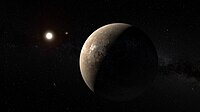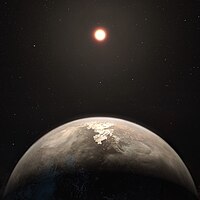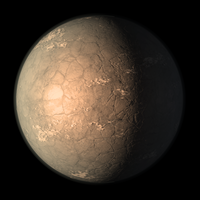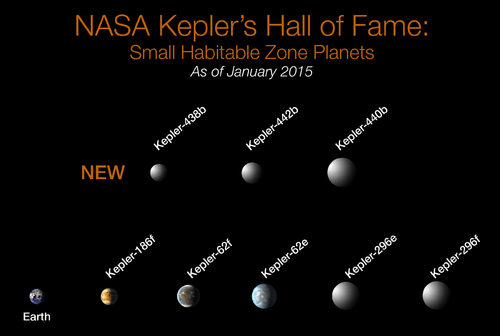Lista över potentiellt beboeliga exoplaneter

Detta är en lista över potentiellt beboeliga exoplaneter, eller exoplaneter som kan vara beboeliga.
Vad en potentiellt beboelig exoplanet är
För att vara potentiellt beboelig, måste en exoplanet ha några viktiga faktorer. Den måste vara terrestrisk, vilket betyder att den måste ha en stenig natur. Gasjättar som Jupiter, eller isjättar som Uranus eller Neptunus har inte steniga naturer, och är därför inte terrestriska. En exoplanet måste också vara i beboeliga zonen av sin stjärna. Beboeliga zonen är zonen runt en stjärna där vatten kan vara flytande. Flytande vatten är också en viktig ingrediens till liv som vi känner till det.[1][2]
Beboeliga exomånar

Kandidater för potentiellt beboeliga ställen utanför solsystemet inkluderar månar. Även om inga potentiellt beboeliga exomånar har upptäckts än, tror man att månar till gasjättar kan vara ett bra ställe för liv som vi känner till det.[3]
Status
Totalt finns de ungefär 2,000 stjärnor inom 50 ljusår inom jorden, och så många som 15% av dem kan ha en planet med en radie som vår jord i sin beboeliga zon.[4] Data från Keplerteleskopet visar att de kan finnas över 40 miljarder potentiellt beboeliga exoplaneter i Vintergatan, med en storlek liknande jordens.[5][6] (fast potentiellt beboeliga planeter behöver inte ha en storlek som jorden).
Lista
| Namn | Bild (impression) | Massa (M⊕) | Radie (R⊕) | Temperatur (Kelvin/Celsius) | Period (dygn) | Avstånd från jorden (ljusår) | Noter |
|---|---|---|---|---|---|---|---|
| Proxima b |  | ≥1,3 | 1,1±0,3 | 255/-18 | 11,2 | 4,2 | |
| Ross 128 b |  | ≥1,5 | 1,1 | 280/6,85 | 9,8658 | 11,03 | |
| Teegardens stjärna b | 1,05 | 301/28 | 4,91 | 12 | |||
| Luyten b | 2,89 | 1,35 | 295/21,85 | 18,65 | 12,4 | ||
| Wolf 1061c |  | 4,3 | ≥2 | 223/-50 | 17,9 | 13,8 | |
| Gliese 667 Cc |  | 3,8 | 1,5±0,5 | 277/3,85 | 28,143 ± 0,029 | 23,6 | [7] |
| Gliese 180 c | ≥6,4 | 1,8 | 239/-34,15 | 24,3 | 38 | ||
| Trappist-1d |  | 0,30 | 0,78 | 258/-15 | 4,05 | 39 | |
| Trappist-1e |  | 0,77 | 0,91 | 230/-43 | 6,1 | 39 | |
| Trappist-1f |  | 0,93 | 1,0406 | 200/-73 | 9,2 | 39 | |
| Trappist-1g |  | 1,34 | 1,127 | 182/-91 | 12,4 | 39 | |
| LHS 1140b |  | 6,6 | 1,43 | 230/-43 | 25 | 40 | |
| HD 40307 g |  | 7,1 | ≥1,8 | 227/-46 | 198 | 42 | |
| Gliese 163 | 7,3 | 2,43 | 227/-46 | 25,6 | 49 | ||
| Kepler-186f |  | 4,7 | 1,17 | 188/-75 | 129,9459 | 561 | |
| Kepler-22b |  | 2,4 | 295/22 | 289 | 619 | ||
| Kepler-296f | 6,1 | 1,8 | 274/0,85 | 63,3 | 737 | ||
| Kepler-296e | 3,3 | 1,5 | 337/63 | 34 | 737 | ||
| Kepler-1229b | 2,7 | 1,40 | 213/-60 | 87 | 769 | ||
| Kepler-440b | 7,7 | 1,860 | 273/0 | 101 | 851 | ||
| Kepler-1544b | 6,6 | 1,8 | 248/-25 | 168,8 | 1 138 | ||
| Kepler-174d | ≥5,5 | 2,19 | 206/-67 | 247 | 1 174 | ||
| Kepler-62e |  | 4,5 | 1,61 | 270/-3 | 122 | 1,200 | [7] |
| Kepler-62f |  | 2,8 | 1,41 | 208/-65 | 267,3 | 1 200 | |
| Kepler-442b |  | 2,3 | 1,34 | 233/-40 | 112,3 | 1 291 | [7] |
| Kepler-452b |  | 5 | 1,5 | 265/-3 | 384,8 | 1 400 | |
| Kepler-283c | 1,8 | 0,90 | 248/-25 | 93 | 1 741 | ||
| Kepler-1638b | 6 | 1,60 | 304/31 | 259 | 2 491 | ||
| Kepler-443b |  | 7 | 2,3 | 247/-26 | 178 | 2 540 | |
| Gliese 180d | |||||||
| Gliese 229 Ac | |||||||
| Gliese 357d | |||||||
| Gliese 433d | |||||||
| Gliese 514d | |||||||
| Gliese 625b | |||||||
| Gliese 1002b | |||||||
| Gliese 1002c | |||||||
| Gliese 1061c | |||||||
| Gliese 1061d | |||||||
| Gliese 3293d | |||||||
| HD 216520c | |||||||
| HIP 38594b | |||||||
| K2-9b | |||||||
| K2-72e | |||||||
| K2-288Bb | |||||||
| K2-332b | |||||||
| Kepler-155c | |||||||
| Kepler-705b | |||||||
| Kepler-1410b | |||||||
| Kepler-1540b | |||||||
| Kepler-1606b | |||||||
| Kepler-1649c | |||||||
| Kepler-1652b | |||||||
| Kepler-1653b | |||||||
| Kepler-1701b | |||||||
| L 98-59f | |||||||
| LP 890-9c | |||||||
| Ross 508b | |||||||
| Teegardens stjärna c | |||||||
| TOI 700d | |||||||
| TOI-2257b | |||||||
| Wolf 1069b |
Tidigare kandidater


HD 85512 b troddes tidigare vara en bra kandidat för beboelighet,[8] men detta har omvärderats och tros inte längre vara beboelig. Kepler-69c troddes också vara beboelig, fast senare visades det att den kan vara som Venus, en varm, obeboelig planet.[9]

Tau Ceti f troddes också vara en beboelig planet, fast senare modeller av beboeliga zonen runt Tau Ceti visade at Tau Ceti f var på yttre kanten av zonen.[10] Gliese 581c troddes också vara beboelig, fast senare visades det att den var för nära sin stjärna.[11]
En till kandidat, KOI-1686.01 troddes vara beboelig, men omvärderades 2015 av NASA som en "falskt positiv".[12]
Galleri



Se även
Andra listor
Andra
Källor
- ^ ”What's the recipe for a habitable exoplanet? | Space | EarthSky” (på amerikansk engelska). earthsky.org. 24 september 2018. https://earthsky.org/space/nasa-nexss-recipe-for-habitable-exoplanets/. Läst 8 juli 2023.
- ^ ”Warm welcome: finding habitable planets”. NASA. Arkiverad från originalet den 16 april 2019. https://web.archive.org/web/20190416215319/https://exoplanets.nasa.gov/the-search-for-life/habitable-zones/. Läst 9 mars 2019.
- ^ Kohler, Susanna (29 augusti 2018). ”Habitable Moons Instead of Habitable Planets?” (på amerikansk engelska). AAS Nova. https://aasnova.org/2018/08/29/habitable-moons-instead-of-habitable-planets/. Läst 8 juli 2023.
- ^ ”Bayesian search for low-mass planets around nearby M dwarfs – estimates for occurrence rate based on global detectability statistics”. academic.oup.com. doi:. https://academic.oup.com/mnras/article/441/2/1545/1059411/Bayesian-search-for-lowmass-planets-around-nearby. Läst 8 juli 2023.
- ^ Overbye, Dennis (4 november 2013). ”Far-Off Planets Like the Earth Dot the Galaxy” (på amerikansk engelska). The New York Times. ISSN 0362-4331. https://www.nytimes.com/2013/11/05/science/cosmic-census-finds-billions-of-planets-that-could-be-like-earth.html. Läst 8 juli 2023.
- ^ Petigura, Erik A.; Howard, Andrew W.; Marcy, Geoffrey W. (2013-11-26). ”Prevalence of Earth-size planets orbiting Sun-like stars” (på engelska). Proceedings of the National Academy of Sciences 110 (48): sid. 19273–19278. doi:. ISSN 0027-8424. PMID 24191033. PMC: PMC3845182. https://pnas.org/doi/full/10.1073/pnas.1319909110. Läst 8 juli 2023.
- ^ [a b c] Martin Mederyd Hårdh (26 juli 2015). ”Här är planeterna som är mest lika Jorden”. Svenska dagbladet. http://www.svd.se/har-ar-planeterna-som-ar-mest-lika-jorden. Läst 1 september 2015.
- ^ A Habitable Planet around HD 85512b? (
 PDF)
PDF) - ^ Administrator, NASA Content (9 april 2015). ”Kepler-69c: Super-Venus”. NASA. http://www.nasa.gov/mission_pages/kepler/multimedia/images/kepler-69c.html. Läst 8 juli 2023.
- ^ published, Mike Wall (24 april 2015). ”Nearby Alien Planets Not So Life-Friendly After All” (på engelska). Space.com. https://www.space.com/29191-exoplanets-tau-ceti-alien-life.html. Läst 8 juli 2023.
- ^ Bloh, W. von; Bounama, C.; Cuntz, M.; Franck, S. (2007-12-01). ”The habitability of super-Earths in Gliese 581” (på engelska). Astronomy & Astrophysics 476 (3): sid. 1365–1371. doi:. ISSN 0004-6361. https://www.aanda.org/articles/aa/abs/2007/48/aa7939-07/aa7939-07.html. Läst 8 juli 2023.
- ^ ”KOI-1686 | NASA Exoplanet Archive”. exoplanetarchive.ipac.caltech.edu. https://exoplanetarchive.ipac.caltech.edu/overview/KOI-1686.01. Läst 8 juli 2023.
Externa länkar
Media som används på denna webbplats
Kepler-69c: Super-Venus
http://www.nasa.gov/mission_pages/kepler/multimedia/images/kepler-69c.html
http://www.nasa.gov/images/content/742553main_Kepler69c_full.jpg
The artist's concept depicts Kepler-69c, a super-Earth-size planet in the habitable zone of a star like our sun, located about 2,700 light-years from Earth in the constellation Cygnus.
Kepler-69c, is 70 percent larger than the size of Earth, and is the smallest yet found to orbit in the habitable zone of a sun-like star. Astronomers are uncertain about the composition of Kepler-69c, but its orbit of 242 days around a sun-like star resembles that of our neighboring planet Venus.
Image credit: NASA Ames/JPL-CaltechThis artist's conception illustrates Kepler-22b, a planet known to comfortably circle in the habitable zone of a sun-like star. It is the first planet that NASA's Kepler mission has confirmed to orbit in a star's habitable zone -- the region around a star where liquid water, a requirement for life on Earth, could persist. The planet is 2.4 times the size of Earth, making it the smallest yet found to orbit in the middle of the habitable zone of a star like our sun. Scientists do not yet know if the planet has a predominantly rocky, gaseous or liquid composition. It's possible that the world would have clouds in its atmosphere, as depicted here in the artist's interpretation.
Författare/Upphovsman: ESO/M. Kornmesser, Licens: CC BY 4.0
This artist’s impression shows the temperate planet Ross 128 b, with its red dwarf parent star in the background. This planet, which lies only 11 light-years from Earth, was found by a team using ESO’s unique planet-hunting HARPS instrument. The new world is now the second-closest temperate planet to be detected after Proxima b. It is also the closest planet to be discovered orbiting an inactive red dwarf star, which may increase the likelihood that this planet could potentially sustain life. Ross 128 b will be a prime target for ESO’s Extremely Large Telescope, which will be able to search for biomarkers in the planet's atmosphere.
Författare/Upphovsman: ESO/spaceengine.org, Licens: CC BY 4.0
This artist’s impression shows the exoplanet LHS 1140b, which orbits a red dwarf star 40 light-years from Earth and may be the new holder of the title “best place to look for signs of life beyond the Solar System”. Using ESO’s HARPS instrument at La Silla, and other telescopes around the world, an international team of astronomers discovered this super-Earth orbiting in the habitable zone around the faint star LHS 1140. This world is a little larger and much more massive than the Earth and has likely retained most of its atmosphere.
Författare/Upphovsman: SolanaBogonPolaris (screenshot), Licens: GPL
The planet Gliese 581 c in Celestia (add on)
Water-worlds are common: Exoplanets may contain vast amounts of water[1]
https://phys.org/news/2018-08-water-worlds-common-exoplanets-vast-amounts.html#nRlv
August 17, 2018, Goldschmidt Conference
---
IMAGE DESCRIPTION
Water-worlds are common: Exoplanets may contain vast amounts of water Exoplanets similar to Earth, artist concept. Credit: NASA
---
Scientists have shown that water is likely to be a major component of those exoplanets (planets orbiting other stars) which are between two to four times the size of Earth. It will have implications for the search of life in our Galaxy. The work is presented at the Goldschmidt Conference in Boston.
The 1992 discovery of exoplanets orbiting other stars has sparked interest in understanding the composition of these planets to determine, among other goals, whether they are suitable for the development of life. Now a new evaluation of data from the exoplanet-hunting Kepler Space Telescope and the Gaia mission indicates that many of the known planets may contain as much as 50% water. This is much more than the Earth's 0.02% (by weight) water content.
"It was a huge surprise to realize that there must be so many water-worlds", said lead researcher Dr. Li Zeng (Harvard University),
Scientists have found that many of the 4000 confirmed or candidate exoplanets discovered so far fall into two size categories: those with the planetary radius averaging around 1.5 that of the Earth, and those averaging around 2.5 times the radius of the Earth.
Now a group of International scientists, after analyzing the exoplanets with mass measurements and recent radius measurements from the Gaia satellite, have developed a model of their internal structure.
"We have looked at how mass relates to radius, and developed a model which might explain the relationship", said Li Zeng. The model indicates that those exoplanets which have a radius of around x1.5 Earth radius tend to be rocky planets (of typically x5 the mass of the Earth), while those with a radius of x2.5 Earth radius (with a mass around x10 that of the Earth) are probably water worlds".
"This is water, but not as commonly found here on Earth", said Li Zeng. "Their surface temperature is expected to be in the 200 to 500 degree Celsius range. Their surface may be shrouded in a water-vapor-dominated atmosphere, with a liquid water layer underneath. Moving deeper, one would expect to find this water transforms into high-pressure ices before we reaching the solid rocky core. The beauty of the model is that it explains just how composition relates to the known facts about these planets".
Li Zeng continued, "Our data indicate that about 35% of all known exoplanets which are bigger than Earth should be water-rich. These water worlds likely formed in similar ways to the giant planet cores (Jupiter, Saturn, Uranus, Neptune) which we find in our own solar system. The newly-launched TESS mission will find many more of them, with the help of ground-based spectroscopic follow-up. The next generation space telescope, the James Webb Space Telescope, will hopefully characterize the atmosphere of some of them. This is an exciting time for those interested in these remote worlds".
Professor Sara Seager, Professor of Planetary Science at Massachusetts Institute of Technology, and deputy science director of the recently-launched TESS (Transiting Exoplanet Survey Satellite) mission, which will search for exoplanets, said:
"It's amazing to think that the enigmatic intermediate-size exoplanets could be water worlds with vast amounts of water. Hopefully atmosphere observations in the future—of thick steam atmospheres—-can support or refute the new findings".
More information: Conference Abstract: Growth Model Interpretation of Planet Size Distribution, Goldschmidt Conference, Boston (2018). Provided by: Goldschmidt Conference
References
- ↑ Water-worlds are common: Exoplanets may contain vast amounts of water. Phys.org (17 August 2018). Retrieved on 17 August 2018.
Författare/Upphovsman: ESO, Licens: CC BY 4.0
Artist's impression of the trio of super-Earths discovered by an European team using the HARPS spectrograph on ESO's 3.6-m telescope at La Silla, Chile, after 5 years of monitoring. The three planets, having 4.2, 6.7, and 9.4 times the mass of the Earth, orbit the star HD 40307 with periods of 4.3, 9.6, and 20.4 days, respectively.
Artist's impression of TRAPPIST-1f planet, as of 2018
Författare/Upphovsman: Ph03nix1986, Licens: CC BY-SA 4.0
Size comparison Kepler-442b and Earth
This artist's concept illustrates a young, red dwarf star surrounded by three planets.
PIA19827: Kepler's Small Habitable Zone Planets
http://photojournal.jpl.nasa.gov/catalog/PIA19827
Of the 1,030 confirmed planets from Kepler, a dozen are less than twice the size of Earth and reside in the habitable zone of their host stars. In this diagram, the sizes of the exoplanets are represented by the size of each sphere. These are arranged by size from left to right, and by the type of star they orbit, from the M stars that are significantly cooler and smaller than the sun, to the K stars that are somewhat cooler and smaller than the sun, to the G stars that include the sun. The sizes of the planets are enlarged by 25 times compared to the stars. The Earth is shown for reference.
NASA Ames manages Kepler's ground system development, mission operations and science data analysis. NASA's Jet Propulsion Laboratory in Pasadena, Calif., managed Kepler mission development. Ball Aerospace & Technologies Corp. in Boulder, Colo., developed the Kepler flight system and supports mission operations with JPL at the Laboratory for Atmospheric and Space Physics at the University of Colorado in Boulder. The Space Telescope Science Institute in Baltimore archives, hosts and distributes the Kepler science data. Kepler is NASA's 10th Discovery Mission and is funded by NASA's Science Mission Directorate at the agency's headquarters in Washington.
More information about the Kepler mission is at http://www.nasa.gov/kepler.
More information about exoplanets and NASA's planet-finding program is at http://planetquest.jpl.nasa.gov.Författare/Upphovsman: Frizaven on English Wikipedia (Originally uploaded on 19:09, 20 March 2006), Licens: GPL
A hypothetical rendition of the Blue Moon created by "Frizaven" on the 3D Space Simulator Celestia, Celestia is copyright free.
Författare/Upphovsman: ESO/L. Calçada, Licens: CC BY 4.0
This artist’s impression shows a sunset seen from the super-Earth Gliese 667 Cc. The brightest star in the sky is the red dwarf Gliese 667 C, which is part of a triple star system. The other two more distant stars, Gliese 667 A and B appear in the sky also to the right. Astronomers have estimated that there are tens of billions of such rocky worlds orbiting faint red dwarf stars in the Milky Way alone.
Författare/Upphovsman: ESO/M. Kornmesser, Licens: CC BY 4.0
This artist’s impression shows the planet orbiting the Sun-like star HD 85512 in the southern constellation of Vela (The Sail). This planet is one of sixteen super-Earths discovered by the HARPS instrument on the 3.6-metre telescope at ESO’s La Silla Observatory. This planet is about 3.6 times as massive as the Earth lis at the edge of the habitable zone around the star, where liquid water, and perhaps even life, could potentially exist
Författare/Upphovsman: ESO/M. Kornmesser, Licens: CC BY 4.0
Artist's impression of the exoplanet Proxima Centauri b shown as of a arid (but not completely water-free) rocky Super-Earth. This appearance is one of several possible outcomes of current theories regarding the development of this exoplanet, while the actual look and structure of the planet is known in no ways at this time. Proxima Centauri b is the closest exoplanet to the Sun and also the closest potentially habitable exoplanet as well. It orbits Proxima Centauri, a red dwarf with a surface temperature of 3040 K (thus hotter than light bulbs and therefore whiter, as depicted here). The Alpha Centauri binary system is shown in the background.
An artist's concept depicting one possible appearance of the planet Kepler-452b, the first near-Earth-size world to be found in the habitable zone of a star that is similar to our sun.
Författare/Upphovsman: Ph03nix1986, Licens: CC BY-SA 4.0
Artist's impression of a superhabitable planet
NASA's Kepler Discovers First Earth-Size Planet In The 'Habitable Zone' of Another Star
April 17, 2014
For more information about the Kepler mission, visit:
http://www.nasa.gov/keplerThis artist's concept depicts Kepler-62f, a super-Earth-size planet in the habitable zone of its star.
Artist's impression of TRAPPIST-1g planet, as of 2018
This artist's concept depicts Kepler-62e, a super-Earth-size planet in the habitable zone of a star smaller and cooler than the sun, located about 1,200 light-years from Earth.
Författare/Upphovsman: Ph03nix1986, Licens: CC BY-SA 4.0
Posible aspecto de Kepler-443b
NASA News
January 6, 2015
http://www.jpl.nasa.gov/news/news.php?release=2015-003
NASA's Kepler Marks 1,000th Exoplanet Discovery, Uncovers More Small Worlds in Habitable Zones
Of the more than 1,000 verified planets found by NASA's Kepler, eight are less than twice Earth-size and in their stars' habitable zone. All eight orbit stars cooler and smaller than our sun. The search continues for Earth-size habitable zone worlds around sun-like stars.
How many stars like our sun host planets like our Earth? NASA's Kepler Space Telescope continuously monitored more than 150,000 stars beyond our solar system, and to date has offered scientists an assortment of more than 4,000 candidate planets for further study -- the 1,000th of which was recently verified.
Using Kepler data, scientists reached this millenary milestone after validating that eight more candidates spotted by the planet-hunting telescope are, in fact, planets. The Kepler team also has added another 554 candidates to the roll of potential planets, six of which are near-Earth-size and orbit in the habitable zone of stars similar to our sun.
Three of the newly-validated planets are located in their distant suns' habitable zone, the range of distances from the host star where liquid water might exist on the surface of an orbiting planet. Of the three, two are likely made of rock, like Earth.
"Each result from the planet-hunting Kepler mission's treasure trove of data takes us another step closer to answering the question of whether we are alone in the universe," said John Grunsfeld, associate administrator of NASA's Science Mission Directorate at the agency's headquarters in Washington. "The Kepler team and its science community continue to produce impressive results with the data from this venerable explorer."
To determine whether a planet is made of rock, water or gas, scientists must know its size and mass. When its mass can't be directly determined, scientists can infer what the planet is made of based on its size.
Two of the newly validated planets, Kepler-438b and Kepler-442b, are less than 1.5 times the diameter of Earth. Kepler-438b, 475 light-years away, is 12 percent bigger than Earth and orbits its star once every 35.2 days. Kepler-442b, 1,100 light-years away, is 33 percent bigger than Earth and orbits its star once every 112 days.
Both Kepler-438b and Kepler-442b orbit stars smaller and cooler than our sun, making the habitable zone closer to their parent star, in the direction of the constellation Lyra. The research paper reporting this finding has been accepted for publication in The Astrophysical Journal.
"With each new discovery of these small, possibly rocky worlds, our confidence strengthens in the determination of the true frequency of planets like Earth," said co-author Doug Caldwell, SETI Institute Kepler scientist at NASA's Ames Research Center at Moffett Field, California. "The day is on the horizon when we'll know how common temperate, rocky planets like Earth are."
With the detection of 554 more planet candidates from Kepler observations conducted May 2009 to April 2013, the Kepler team has raised the candidate count to 4,175. Eight of these new candidates are between one to two times the size of Earth, and orbit in their sun's habitable zone. Of these eight, six orbit stars that are similar to our sun in size and temperature. All candidates require follow-up observations and analysis to verify they are actual planets.
"Kepler collected data for four years -- long enough that we can now tease out the Earth-size candidates in one Earth-year orbits," said Fergal Mullally, SETI Institute Kepler scientist at Ames who led the analysis of a new candidate catalog. "We're closer than we've ever been to finding Earth twins around other sun-like stars. These are the planets we're looking for."
These findings also have been submitted for publication in The Astrophysical Journal Supplement.
Work is underway to translate these recent discoveries into estimates of how often rocky planets appear in the habitable zones of stars like our sun, a key step toward NASA's goal of understanding our place in the universe.
Scientists also are working on the next catalog release of Kepler's four-year data set. The analysis will include the final month of data collected by the mission and also will be conducted using sophisticated software that is more sensitive to the tiny telltale signatures of small Earth-size planets than software used in the past.
Ames is responsible for Kepler's mission operations, ground system development and science data analysis. NASA's Jet Propulsion Laboratory in Pasadena, California, managed Kepler mission development. Ball Aerospace & Technologies Corp. in Boulder, Colorado, developed the Kepler flight system and supports mission operations with the Laboratory for Atmospheric and Space Physics at the University of Colorado in Boulder. The Space Telescope Science Institute in Baltimore archives, hosts and distributes Kepler science data. Kepler is NASA's 10th Discovery Mission and was funded by the agency's Science Mission Directorate in Washington.
For more information about the Kepler mission, visit:
http://www.nasa.gov/keplerArtist's impression of TRAPPIST-1e planet, as of 2018
Artist's impression of TRAPPIST-1d planet, as of 2018
























